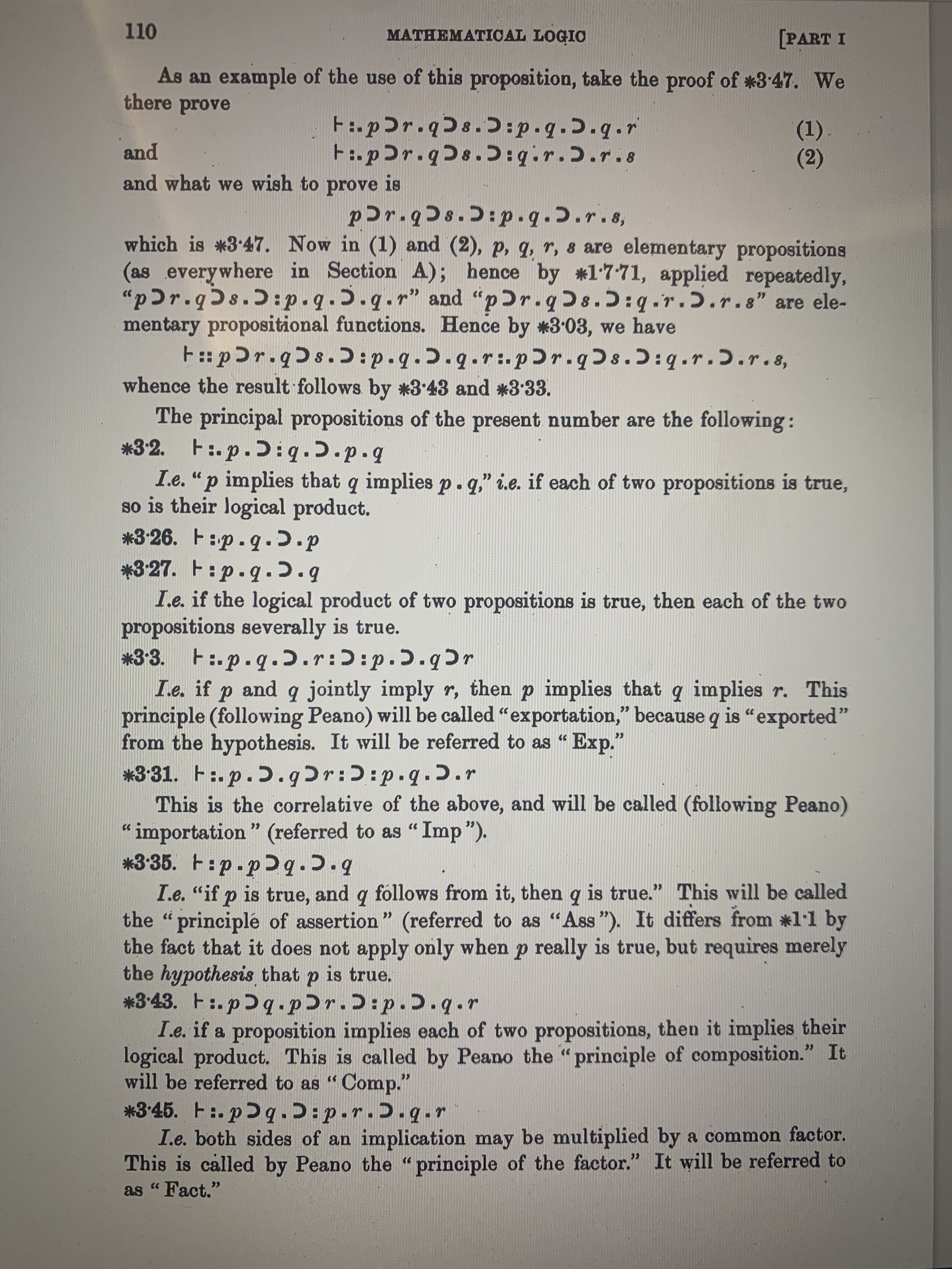校稿任务 有悬赏
一页2元 共60页 先给定金5元 先校稿一次看是否录取 下面是word 标准看照片
来稿请联系邮箱 价钱可议
1317830233@qq.com
As an example of the use of this proposition, take the proof of *3 47. We there prove
Y- :.pDr. qD s .D ip .q .q .r (1)
and l-t.pDr.qDs.'Diq.r.D.r.s (2)
and what we wish to prove is
p^r. s ip. q ."D .r. s,
which is *3,47. Now in (1) and (2), p, q, r, s are elementary propositions (as everywhere in Section A); hence by applied repeatedly,
“p D r. g D s . D . g. 5 . g.俨”and <{ r. q 3 s. D t q . r. . r. s}, are elementary propositional functions. Hence by *3,03, we have
I- tz p3r .q"D s .D t p .q .D . q .r t.pDr .q3 s .D z q .r .D .r. s, whence the result follows by *3*43 and 来3,33.
The principal propositions of the present number are the following:
*3,2. F t.p .D:q.D .p .q
I.e. ltp implies that g implies p ・ q'f i.e. if each of two propositions is true, so is their logical product.
*3*26.卜叩.g.D*
*3'27.卜:p . g . D . g
I.e. if the logical product of two propositions is true, then each of the two propositions severally is true.
*3'3. F i.p . q .D .r :D :p .q3r
I.e. if p and q jointly imply r, then p implies that q implies r. This principle (following Peano) will be called "exportation," because q is "exported" from the hypothesis. It will be referred to as " Exp."
*3"31. p .D . qD r t p .q .D .r
This is the correlative of the above, and will be called (following Peano) “ importation " (referred to as " Imp ").
*3'35. b ip .pDq.D .q
I.e. "ifis true, and q follows from it, then q is true." This will be called the "principle of assertion" (referred to as "Ass"). It differs from *11 by the fact that it does not apply only when p really is true, but requires merely the hypothesis that p is true.
*3'43. :.pD q .pD r .D z p . q .r
I.e. if a proposition implies each of two propositions, then it implies their logical product. This is called by Peano the <{ principle of composition.M It will be referred to as “ Comp."
*3,45. \-z.p3q.
来稿请联系邮箱 价钱可议
1317830233@qq.com
As an example of the use of this proposition, take the proof of *3 47. We there prove
Y- :.pDr. qD s .D ip .q .q .r (1)
and l-t.pDr.qDs.'Diq.r.D.r.s (2)
and what we wish to prove is
p^r. s ip. q ."D .r. s,
which is *3,47. Now in (1) and (2), p, q, r, s are elementary propositions (as everywhere in Section A); hence by applied repeatedly,
“p D r. g D s . D . g. 5 . g.俨”and <{ r. q 3 s. D t q . r. . r. s}, are elementary propositional functions. Hence by *3,03, we have
I- tz p3r .q"D s .D t p .q .D . q .r t.pDr .q3 s .D z q .r .D .r. s, whence the result follows by *3*43 and 来3,33.
The principal propositions of the present number are the following:
*3,2. F t.p .D:q.D .p .q
I.e. ltp implies that g implies p ・ q'f i.e. if each of two propositions is true, so is their logical product.
*3*26.卜叩.g.D*
*3'27.卜:p . g . D . g
I.e. if the logical product of two propositions is true, then each of the two propositions severally is true.
*3'3. F i.p . q .D .r :D :p .q3r
I.e. if p and q jointly imply r, then p implies that q implies r. This principle (following Peano) will be called "exportation," because q is "exported" from the hypothesis. It will be referred to as " Exp."
*3"31. p .D . qD r t p .q .D .r
This is the correlative of the above, and will be called (following Peano) “ importation " (referred to as " Imp ").
*3'35. b ip .pDq.D .q
I.e. "ifis true, and q follows from it, then q is true." This will be called the "principle of assertion" (referred to as "Ass"). It differs from *11 by the fact that it does not apply only when p really is true, but requires merely the hypothesis that p is true.
*3'43. :.pD q .pD r .D z p . q .r
I.e. if a proposition implies each of two propositions, then it implies their logical product. This is called by Peano the <{ principle of composition.M It will be referred to as “ Comp."
*3,45. \-z.p3q.
没有找到相关结果
已邀请:
这是啥?看不明白啊






lxy8960 • 2021-07-22 20:04
照片是pdf 上面的文字是扫描的word 需要 把word校稿成和pdf一样的